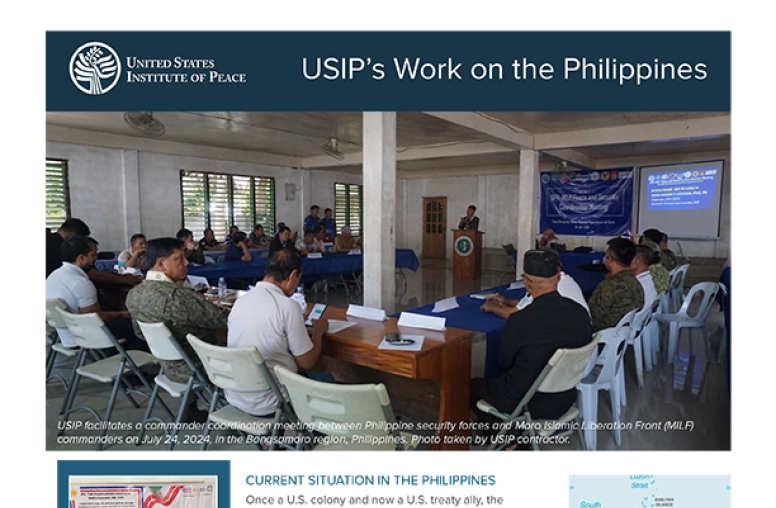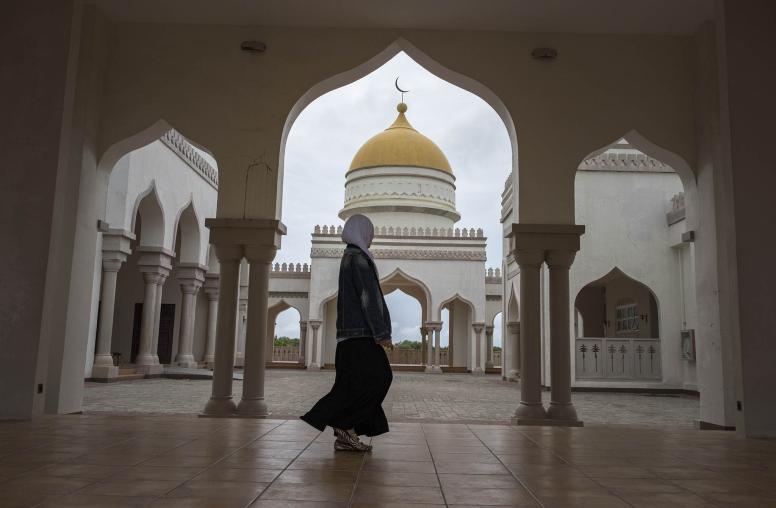The Long Road to Peace in the Southern Philippines
USIP editorial series provides perspectives from the Bangsamoro region.
For four centuries, the Muslim-majority areas in the southern reaches of the Philippines have resisted domination authorities in Manila, the capital city of the Philippines, whether its leaders were Spanish, American or Filipino. This dynamic has spawned insurgencies, glimmers of hope for peaceful coexistence and repeated disappointment — all amid endemic violence and poverty.

Over the past five and a half years, while the world has focused on Philippines President Rodrigo Duterte’s excesses, particularly his deadly war on drugs, a groundbreaking possibility for peace has emerged under the first president of the Philippines to hail from Mindanao, the second-largest island located in the southern part of the archipelago.
As the Philippines gears up for general elections in May 2022 that will see a term-limited Duterte cede power, there is an urgent need for Manila and the international community to support the most promising opportunity for a sustainable peace in Mindanao in decades, a hopeful development that has too often flown under the radar.
The United States has a stake in peace in the Southern Philippines, most acutely on two fronts. First, as the United States and the Philippines work to deepen cooperation on external security challenges, principally in the South China Sea, peace in Mindanao would remove a key domestic focus for the armed forces of the Philippines and free resources for other priorities. Second, sustainable peace — and good local governance — would significantly help to address drivers of transnational crime, including terrorism.
It is within this context that the U.S. Institute of Peace is launching an initiative to bring attention to the peace process and the development of the Bangsamoro Autonomous Region in Muslim Mindanao (BARMM), which was established in early 2019 as part of a peace agreement to end nearly five decades of conflict between the Philippine government and Moro secessionists in Mindanao. This effort will include a series of articles written by Filipino authors that analyze key issues and challenges at this historic juncture of Bangsamoro peace efforts.
The Latest Push for Peace in Mindanao
The establishment of the BARMM in 2019 brought with it the most promising opportunity for sustainable peace in living memory. After decades of war and cyclical peace process failures, an 80-member Bangsamoro Transition Authority (BTA) was appointed by Duterte to implement the two-track peace process and take the region to its first elections in May 2022. Most BTA ministers are former guerrillas who had devoted their lives to revolutionary war but now were responsible for founding a parliamentary system, implementing a legal and policy architecture, establishing government bureaucracies, decommissioning combatants and providing basic services to their impoverished communities.
Under any circumstances, the challenges facing the new Bangsamoro authorities were immense and the timelines in the Bangsamoro Organic Law for achieving key political, legal and normalization milestones overly optimistic. But then, almost a year into the transition period, COVID-19 hit the Philippines. By mid-2020, the BTA was increasingly (and understandably) prioritizing its pandemic response. By the end of 2020, Bangsamoro authorities and civil society were calling for an extension of the transition period, which was eventually granted and signed into law by Duterte on October 28, 2021. The extension grants Bangsamoro authorities three more years to complete the transition process and take the BARMM to its first elections in May 2025.
While the extension may have given the BTA more time, it has done little to relieve pressures on Bangsamoro authorities to succeed in their efforts. For instance, expectation management is a concern for every peace process, but it is especially concerning in the BARMM. In many communities, hopes for what peace dividends will deliver socially, economically and politically are extraordinarily high, highlighting the potential for acute disappointment if those hopes are not met. One of the most concerning issues has been the faltering normalization track that was meant to decommission 40,000 ex-combatants, their arms and camps but has left many disgruntled and many more still needing to be processed.
Extension has also brought with it added uncertainties. For example, a clause in the transition extension means that new BTA ministers could be appointed by either Duterte or the newly elected president in May 2022. At the first Bangsamoro Donor’s Forum organized by the Bangsamoro Planning and Development Authority on December 13, 2021, it was clear that at this historic juncture in the struggle for peace in Mindanao there are plenty of reasons to be cautiously optimistic for the future.
As the authors featured in this USIP series explore, the Bangsamoro region is delicately balanced and the resolution (or otherwise) of some key issues may prove the difference between a peaceful and even prosperous BARMM or another generation traumatized by war.
Inside the Struggle for Peace in the Bangsamoro Region
This USIP series seeks to bring attention to peace efforts in the Southern Philippines by showcasing a broad thematic and multisector spectrum of local perspectives from inside the BARMM. The Filipino contributors featured in this series will explore a range of challenges and opportunities for peace in the Bangsamoro region. From the vital role of Bangsamoro women as peace leaders and the key issues associated with the extension of the transition period to the Bangsamoro government’s inclusivity challenge and the impact of COVID-19 on the achievement of peace and development milestones, the series will take readers inside the multisector effort to achieve peace in Mindanao.
If there is one overarching theme that unites this eclectic collection of authors and subjects, it is the issue of balance. For the Bangsamoro, this challenge arises in discovering how to both embrace and protect the region’s rich ethnic and cultural diversity while also championing a shared Bangsamoro identity. History offers its own challenges as a source of traumas that weigh heavily on the present, as well as a source of immense pride and inspiration. After decades of bloody wars and failed peace efforts, local expectations for what the peace dividends should deliver will need to be balanced by the realities of what can be delivered. All the while, peace spoilers will be looking to exploit any opportunity to tip the balance once again toward war.
Hanging in the Balance
The picture that will emerge from this series is of a complicated and delicately balanced peace process that has every reason to succeed or fail. If there is one lesson to emerge from Mindanao’s too-often bloody history, it is that the aftermaths of failed peace efforts have been a boon for the rise of violent groups exploiting the politics of dashed expectations. For the international community to appreciate why the current confluence of dynamics in the BARMM is raising the stakes for the peace process, it is vital to read the nuanced ground-level perspectives of locals on the inside of the peace process.



